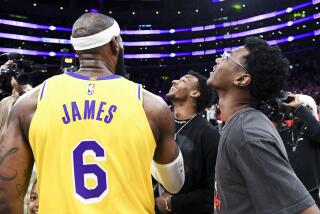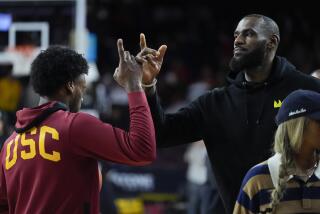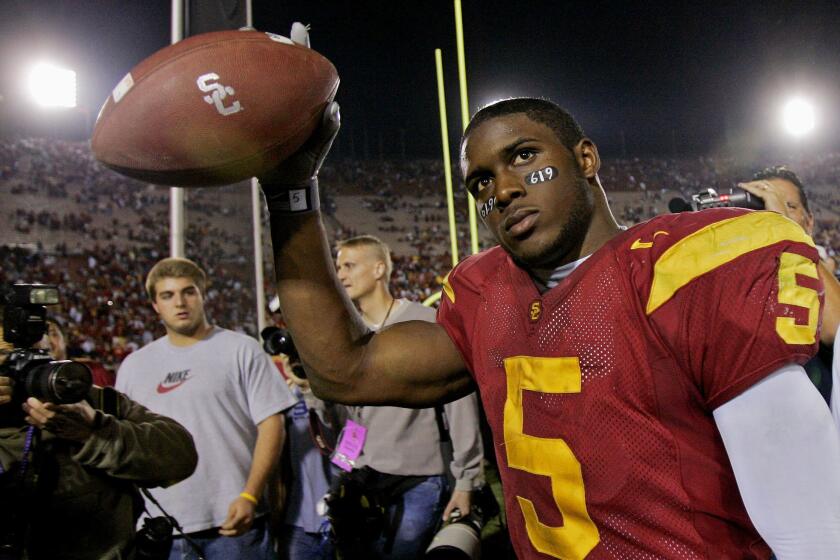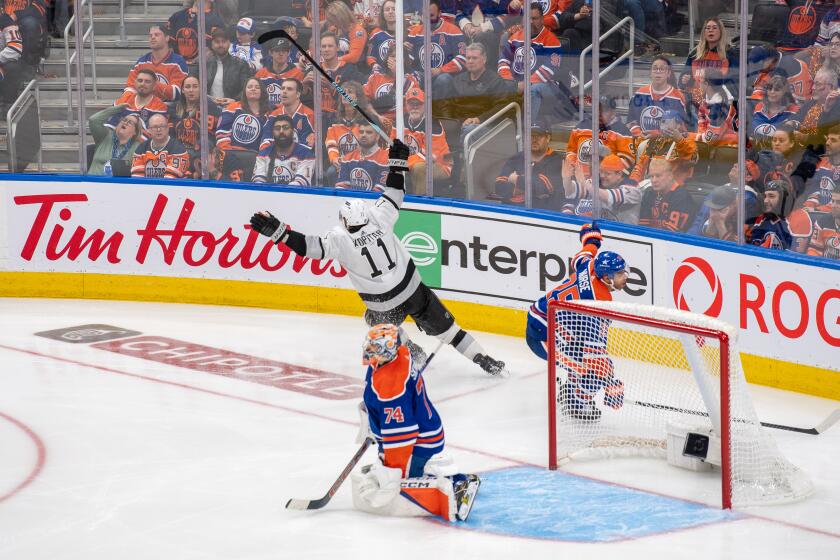LeBron James never forgot where he came from and they never forgot him

On the evening before school starts, the children of the Boondocks enjoy one last hour of summer by driving Grammy crazy. They jump on the trampoline until she worries it might break, scatter her plastic cups over the street and climb up the basketball hoop while playing Heat vs. Thunder.
The Boondocks is a dot in northwest Akron cradled from the city’s encroachment by a parallel band of railroad track. Walk five minutes from the buildings of downtown, descend the hill past new homes with the porch swings and fresh paint, and there you are, on Overlook Place.
“I think that’s why they named it Overlook,” Grammy, whose name is Wanda Reaves, says as she sits on her porch watching the youngsters play. “Because if you go too fast, you overlook it.”
The neighborhood is tucked in an isolated patch of the city, but every few years the residents celebrate when they see a Hummer rumbling down the street. Everyone knows it’s basketball star LeBron James, returning home to where he first played the game.
James’ draw to his roots has been a major part of his career. He was drafted out of high school by his hometown team, the Cleveland Cavaliers, and quickly became one of the NBA’s best players.
Fans burned his jersey when, in his prime, he left to chase championships for Miami in 2010. And they wept with joy when he returned to Cleveland in July. The Cavaliers play their season opener Thursday at home against the New York Knicks.
“My relationship with Northeast Ohio is bigger than basketball,” James wrote in Sports Illustrated about his decision. “People there have seen me grow up. I sometimes feel like I’m their son.”
James’ mother, Gloria, gave birth to him when she was 16. His father was never an influence. From the age of 3 until he was in high school, James never had a permanent home. He slept on a lot of couches.
“He was raised by many people,” Reaves says.
::
Some parts of the country might struggle to understand how an athlete could engender such passion, why the draw home could be so strong. James declined to be interviewed for this story, but a visit to west Akron, where he was raised and friends and family members remain, offers clues.
Four small houses still stand in the Boondocks. The city wants to replace them with nicer homes, but the residents want to stay.
As a boy, James lived for a time in a corner home across the street from Reaves. The house was razed long ago; what remains is a lot overgrown with thickets of hickory and poplar trees.
Four generations of James’ family lived in that house — uncles and grandparents all the way up to his great-grandmother, who was known in the neighborhood as Big Ma. In the back was a barn with horses and goats.
James first picked up a basketball here. Nails were pilfered from the barn, hammered straight, and used to fasten a milk crate to a telephone pole. That was the first hoop. The nails are still there.
Big Ma died in 1987, the same year as her daughter. James was still a toddler.
Gloria and her brothers struggled to pay the bills, and eventually the city shut off the heat. With cold setting in, Reaves’ children posed a question: “Can they come over here?”
“I hate the thought of anybody being in the cold,” Reaves says.
James slept on the couch. Reaves’ son and other older boys from the area taught him his first basketball moves under the milk-crate hoop. They were taller and stronger and smacked the ball from his hands, but when they grew bored James practiced alone until the sun ducked behind the trees and Reaves called him in.
James stayed with Reaves for about four months, then bounced between Gloria’s other friends and family. In fourth grade, the moves wearing on him, James missed almost 100 days of school.
A turning point came one day as James was playing sandlot football with some older friends. A coach approached saying he was looking for some new players. Bruce Kelker was his name, and he had been tipped off by James’ godfather.
“Which one’s LeBron?” Kelker said to one of the boys.
The boy pointed to his tall friend and Kelker recalls thinking, “There’s no way that kid is 9 years old.”
Kelker lined up the four boys and had them race. He gets excited recounting what happened next: James won easily.
“I said, ‘Ooooooh!’” Kelker says, bringing a fist to his open mouth, “‘He’s fast too!’”
::
James took his first handoff in a football game and ran for a long touchdown — 80 yards, according to Kelker. It didn’t take long before parents around the league were complaining that the James boy was too big and too fast to be the age he claimed. They wanted to see a birth certificate.
Hurt by the accusations, James tried his best to blend in, hunching over in the huddle until his coach brought an end to it. Stand tall and proud, Kelker told him.
Soon, Kelker invited James and Gloria to live with him. There was no romance, Kelker says. He simply offered a stable environment for the two of them.
Kelker remembers details only a housemate would know. He would tease James — “That boy had the stinkiest feet in the world” — and joke that he was going to throw his shoes in the laundry.
They both loved the nights Gloria made Hamburger Helper, secretly competing to get their plate fixed first. “He’s sitting there like he’s the doggone king,” Kelker says. “Even back then.”
After football, Kelker suggested a friend, Frankie Walker, take a look at James as a basketball player.
Walker matched one of his sons against James in a one-on-one game to 21. His dribbling sloppy and his shooting off target, James lost, 21-7. Walker stuck with him, though, becoming the second coach to take James into his home.
A month later, Kelker saw James again and couldn’t believe he was watching the same player. James was already finishing shots with both hands.
As he recalls James’ development, Kelker is sitting on a blue plastic chair outside a friend’s house on The Hill, south of the Boondocks. The friend, nicknamed Klean, has always smoked the best ribs in the neighborhood. Even recently, members of James’ inner circle have dropped by Klean’s house to pick up ribs for barbecues.
Kelker is asked: would he have stepped in as he did had James not been athletically gifted?
“That’s a good question,” Kelker says.
He answers with a story: As he was growing up in The Valley, inner-city Akron, Kelker’s mother had given him a choice. Either she could pay his entry fee for a football team or she could buy him a new pair of Chuck Taylors for school.
“Of course, I took the Chucks,” Kelker says.
Kelker says he got into coaching in order to save other youngsters that kind of choice. He did what he could for his players, helping them get equipment or paying league fees.
Kelker and Reaves both theorize that James returns to his old neighborhoods because the people there helped him when he had nothing to give in return.
So Kelker’s answer is yes. He would have helped anyway.
“I mean, who knew?” Kelker says. “Who knew?”
::
Exactly when James became known as a prodigy isn’t clear, but what happened in an old, cramped Akron gym has become legendary.
The students of Riedinger Middle School had gotten out of class early for the annual student-faculty basketball game, and they were already raucous. For as long as anyone could remember, the teachers had been undefeated. But this time, word was already out about the opposition.
James’ team had gone undefeated and won the city championship for its age group. And the club team he belonged to had advanced to the AAU national championship game.
The teachers were worried enough that they brought in ringers from the high school and athletes from the Akron Police Department.
The game was close for a while, but the middle school boys kept running and gradually pulled away as the crowd grew louder still.
Then there was a long pass, and . . . describing it later, James said he didn’t know what got into him. It has happened thousands of times since — James with the basket in front of him and no one in his path. Before that day, though, he had never dunked.
He went up, and the ball barely got over the rim. The students went wild.
“Yeah, he punched it,” recalls Jamie Donald, the gym teacher who organized the game and played for the faculty. “He punched it really good.”
Later, Donald took down the rim and kept it for posterity.
The teacher says after that more and more people recognized James’ potential, and the young man seemed to grow a few inches overnight.
When he was in high school, a local newspaper article referred to LeBron as “King James,” and the nickname stuck.
Early on, he caught the attention of Chris Dennis, who ran a mentoring program in Akron. After James’ freshman year in high school, Dennis showed a videotape of him to Sonny Vaccaro, the Nike executive and basketball camp founder.
“LeBron, he was Michael Jackson,” Dennis says. “Michael Jackson doesn’t need to be dancing downtown at the Civic Theatre. He needs to be in Hollywood.”
After a breakout performance at Vaccaro’s showcase camp, ESPN magazine called James “NEXT.” Sports Illustrated crowned him “THE CHOSEN ONE.”
Dennis became one of James’ trusted advisers. By then, James and his mother had their own apartment on the west side of the city, and Dennis was there most days.
Recently, Dennis tried to go back to the top floor, where James had lived. He didn’t make it past the lobby. There had been a shooting and a group of uniformed police officers controlled the entrance.
“It was nothing but a little two-bedroom,” Kelker said, “but it was theirs. And all the teammates would come over there and spend the night with them.”
Gloria couldn’t understand it, Kelker says. Why did all those boys want to spend the night there? Most had nicer places of their own.
But to people like Reaves, Kelker and Dennis, it made plenty of sense. His whole life, James had lived off of friends’ couches. Now his friends would stay with him.
::
Akron is only 40 miles from Cleveland, which makes James the rare NBA superstar to play the majority of his professional career for his hometown team. It’s a connection that defines him.
As a child, he and other youngsters from the neighborhood walked the railroad tracks to the St. Vincent-St. Mary’s High football field, where they could sneak in without paying. James later attended the school, married his high school sweetheart, and now the gym is named in his honor.
After turning pro, James moved to the northwestern outskirts of Akron and kept the place even when he left for Miami.
Grammy was never a big basketball fan, but she fell hard for the sport when James signed with Cleveland. On the porch, she wears a red No. 23 Cavaliers shirt. After James left for Miami, Reaves says she rooted for him. When the Heat played the Cavaliers she wished him well, but she cheered for Cleveland.
“I didn’t want him to leave,” Reaves says. “But I still loved him. I still cared about him. I certainly didn’t burn any jerseys because he left.”
In the summer of 2010, when James chose to play for Miami, the backlash wasn’t as intense in Akron as it was in Cleveland. Some people felt jilted, but others switched allegiances. “Akron Heat” gear sold by one company became popular. James appeared in a photo wearing an Akron Heat hat.
Kelker says he was surprised James left, but he wasn’t angry.
Dennis was proud. He always wanted James to take charge of his life. Even if the split was emotional, the decision showed James was in control.
“No matter how it was done, he sent a message,” Dennis says. “He’s going to make his own decisions, he’s going to be his own man.”
After choosing Miami, James dropped by the Boondocks unannounced for a cookout. When someone shouted “LeBron’s here!” half the neighborhood came running.
James gave Reaves a hug and told her son that he taught him his first basketball moves.
Reaves’ neighbor, Ben Brown, recalls noting a discoloration on James’ neck. On message boards online, where James’ every move and look is parsed, people have wondered if it was caused by some disorder, or was perhaps somehow linked to his perplexing hairline.
“I call it the Boondock Disease,” Brown says. He guesses half the local children carry similar marks, a scar of sorts, maybe from poison ivy.
He laughs: You can leave Akron, you can leave the Boondocks. But the Boondocks will leave its mark.
In front of Brown’s house, as the sun sets and the trains thunder by, a new generation of children play basketball using a real hoop. Reaves’ granddaughter dominates even the boys.
Reaves watches, and recalls being in about the same place when she learned of James’ return to the Cavaliers. Someone had heard the news and called a friend who called a friend who called a friend who lives in the Boondocks.
Reaves hollered at the neighbors.
“LeBron’s coming back! He’s coming home!”
More to Read
Get our high school sports newsletter
Prep Rally is devoted to the SoCal high school sports experience, bringing you scores, stories and a behind-the-scenes look at what makes prep sports so popular.
You may occasionally receive promotional content from the Los Angeles Times.







